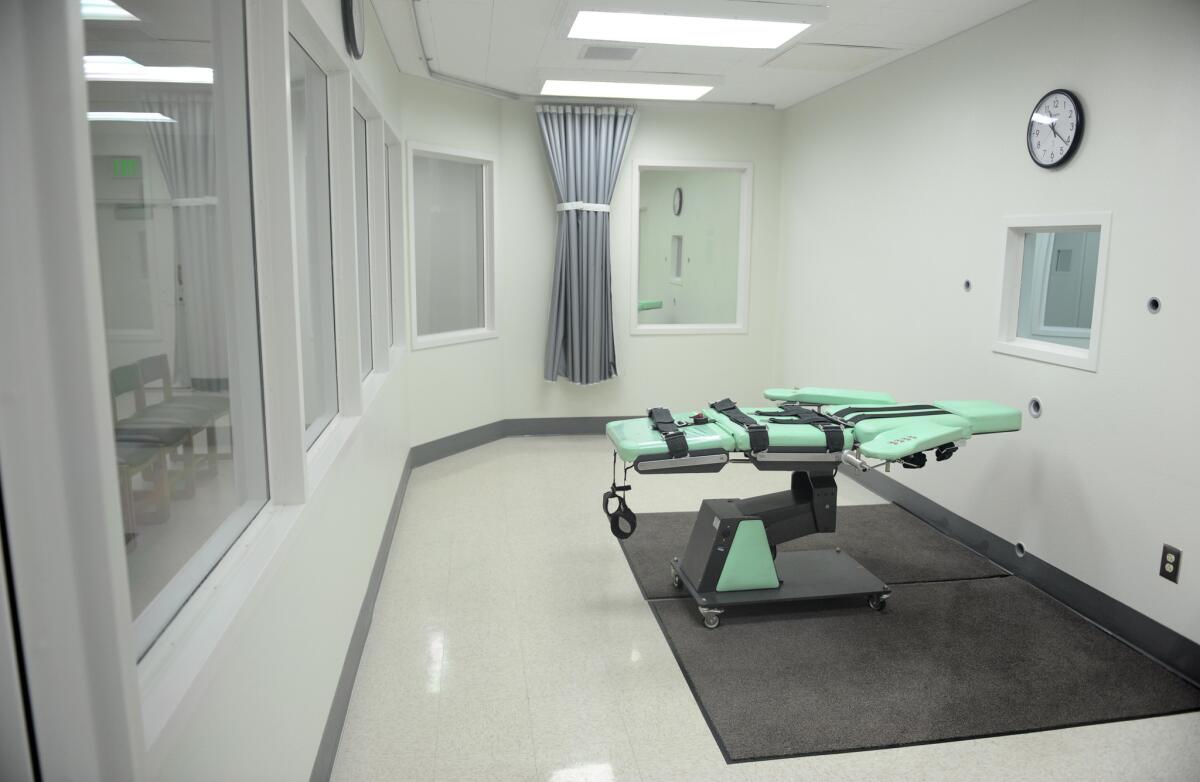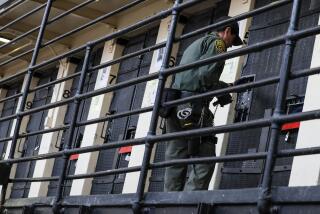Judges’ procedural questions hint at skepticism on California death penalty ban

A federal appeals court heard arguments Monday in Pasadena on the constitutionality of California’s death penalty. Above, the San Quentin execution chamber.
- Share via
California’s death penalty system, plagued by delays and inadequate funding, may survive an appeals court’s scrutiny because of legal rules that limit federal oversight, a U.S. court panel indicated Monday.
During a hearing before a U.S. 9th Circuit Court of Appeals panel, three judges focused on procedural land mines that could imperil last year’s ruling by U.S. District Judge Cormac Carney declaring California’s system of capital punishment unconstitutional. None of the 9th Circuit judges revealed any leanings, but all focused on legal rules that might require them to overturn Carney’s decision.
Judge Paul J. Watford, an Obama appointee, said he had “major problems” with the fact that Carney ruled on an issue not yet addressed by the California Supreme Court.
Carney determined that decades-long delays and dysfunction render California’s death penalty arbitrary and unconstitutional. Legal rules require death row inmates to litigate or “exhaust” all their claims in state court, except in rare cases, before federal judges may review them.
Michael Laurence, representing death row inmate Ernest Jones, said the rules don’t apply when the state has caused the problem and has no remedy to fix it. If the 9th Circuit sends the case back to the California Supreme Court, four more years will pass before a decision, and even then, it will probably be a terse rejection sent on a postcard, Laurence said.
“If the California Supreme Court truly wanted to resolve this question in an expeditious manner, it would have done so a year ago,” Laurence said.
Watford seemed dubious. Exceptions to the so-called “exhaustion” rule generally have been limited to cases that have been pending before state courts for many years without a resolution, he said.
“Here, your client hasn’t even tried yet,” Watford said.
Judge Susan P. Graber, a Clinton appointee, suggested the state high court might already have rejected the constitutional argument, albeit in a more narrow context. Federal courts are supposed to defer to decisions by state judges in criminal cases.
“The California Supreme Court has made it quite clear that the record in this case does not warrant relief on the merits,” Graber said.
Judge Johnnie B. Rawlinson, another Clinton appointee, questioned whether Carney’s ruling was based on direct U.S. Supreme Court precedent.
“I am having difficulty with your argument,” she told Laurence. “Has the Supreme Court ever said the fact that one is lingering on death row for a finite number of years or an infinite number of years constitutes a constitutional violation?”
Laurence argued that the Supreme Court had held that federal courts must guard against “extreme malfunctions” in the state court and arbitrary imposition of the death penalty.
California’s system is so underfunded that inmates must wait many years to obtain lawyers for appeals and many more years for their appeals to be filed and decided, he said.
“I don’t think it is a stretch to say that a system that produces such lengthy delays constitutes a gross malfunction,” Laurence argued.
Deputy Solicitor Gen. Michael J. Mongan, arguing for Atty. Gen. Kamala D. Harris, countered that Carney’s ruling was “novel.”
“It is absolutely the case that the review process in California is a lengthy one,” Mongan said. But the delays do not mean a death sentence “is arbitrary or that it produces random results.”
Loyola Law School professor Laurie Levenson, who attended the hearing, said it appeared death penalty opponents faced “an uphill battle” with the court.
Cautioning that predicting a hearing’s outcome amounted to reading tea leaves, she said: “The tea leaves said to me that the panel would be most comfortable sending it back” to state court.
The case heard Monday was based on an appeal by Jones, who has been on death row for 20 years for the 1992 rape and killing of Julia Miller, his girlfriend’s mother. Jones killed Miller 10 months after being paroled for a previous rape.
The California Supreme Court twice rejected appeals that could have overturned Jones’ sentence. When the case got to federal court, Carney asked the lawyers to focus on whether persistent and random delays in the system might make it unconstitutional. The decision by Carney, appointed by President George W. Bush, was put on hold after the state appealed.
California has the largest death row in the nation — more than 750 inmates — but has executed only 13 people since 1978. Despite a critical 2008 state commission report, lawmakers have failed to raise spending to speed up the process.
The state doesn’t even have a court-approved method for lethal injection. Gov. Jerry Brown, prodded by a lawsuit, is expected to soon unveil a single-drug procedure, but it will have to be vetted and could be challenged in court.
An attempt to end the state’s death penalty failed in 2012, when voters narrowly rejected a ballot measure to replace it with life without the possibility of parole.
Twitter: @mauradolan
More to Read
Sign up for Essential California
The most important California stories and recommendations in your inbox every morning.
You may occasionally receive promotional content from the Los Angeles Times.











